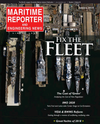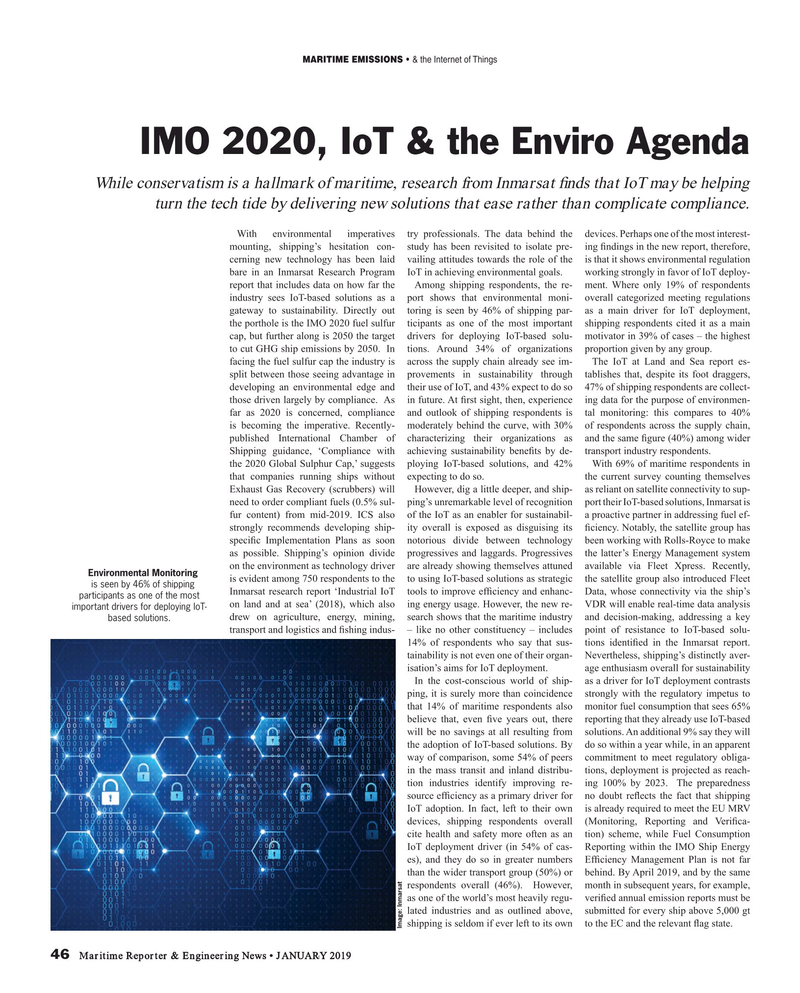
Page 46: of Maritime Reporter Magazine (January 2019)
Ship Repair & Conversion: The Shipyards
Read this page in Pdf, Flash or Html5 edition of January 2019 Maritime Reporter Magazine
MARITIME EMISSIONS • & the Internet of Things
IMO 2020, IoT & the Enviro Agenda
While conservatism is a hallmark of maritime, research from Inmarsat ? nds that IoT may be helping turn the tech tide by delivering new solutions that ease rather than complicate compliance.
With environmental imperatives try professionals. The data behind the devices. Perhaps one of the most interest- mounting, shipping’s hesitation con- study has been revisited to isolate pre- ing ? ndings in the new report, therefore, cerning new technology has been laid vailing attitudes towards the role of the is that it shows environmental regulation bare in an Inmarsat Research Program IoT in achieving environmental goals. working strongly in favor of IoT deploy- report that includes data on how far the Among shipping respondents, the re- ment. Where only 19% of respondents industry sees IoT-based solutions as a port shows that environmental moni- overall categorized meeting regulations gateway to sustainability. Directly out toring is seen by 46% of shipping par- as a main driver for IoT deployment, the porthole is the IMO 2020 fuel sulfur ticipants as one of the most important shipping respondents cited it as a main cap, but further along is 2050 the target drivers for deploying IoT-based solu- motivator in 39% of cases – the highest to cut GHG ship emissions by 2050. In tions. Around 34% of organizations proportion given by any group. facing the fuel sulfur cap the industry is across the supply chain already see im- The IoT at Land and Sea report es- split between those seeing advantage in provements in sustainability through tablishes that, despite its foot draggers, developing an environmental edge and their use of IoT, and 43% expect to do so 47% of shipping respondents are collect- those driven largely by compliance. As in future. At ? rst sight, then, experience ing data for the purpose of environmen- far as 2020 is concerned, compliance and outlook of shipping respondents is tal monitoring: this compares to 40% is becoming the imperative. Recently- moderately behind the curve, with 30% of respondents across the supply chain, published International Chamber of characterizing their organizations as and the same ? gure (40%) among wider
Shipping guidance, ‘Compliance with achieving sustainability bene? ts by de- transport industry respondents. the 2020 Global Sulphur Cap,’ suggests ploying IoT-based solutions, and 42% With 69% of maritime respondents in that companies running ships without expecting to do so. the current survey counting themselves
Exhaust Gas Recovery (scrubbers) will However, dig a little deeper, and ship- as reliant on satellite connectivity to sup- need to order compliant fuels (0.5% sul- ping’s unremarkable level of recognition port their IoT-based solutions, Inmarsat is fur content) from mid-2019. ICS also of the IoT as an enabler for sustainabil- a proactive partner in addressing fuel ef- strongly recommends developing ship- ity overall is exposed as disguising its ? ciency. Notably, the satellite group has speci? c Implementation Plans as soon notorious divide between technology been working with Rolls-Royce to make as possible. Shipping’s opinion divide progressives and laggards. Progressives the latter’s Energy Management system on the environment as technology driver are already showing themselves attuned available via Fleet Xpress. Recently,
Environmental Monitoring is evident among 750 respondents to the to using IoT-based solutions as strategic the satellite group also introduced Fleet is seen by 46% of shipping
Inmarsat research report ‘Industrial IoT tools to improve ef? ciency and enhanc- Data, whose connectivity via the ship’s participants as one of the most on land and at sea’ (2018), which also ing energy usage. However, the new re- VDR will enable real-time data analysis important drivers for deploying IoT- drew on agriculture, energy, mining, search shows that the maritime industry and decision-making, addressing a key based solutions. transport and logistics and ? shing indus- – like no other constituency – includes point of resistance to IoT-based solu- 14% of respondents who say that sus- tions identi? ed in the Inmarsat report. tainability is not even one of their organ- Nevertheless, shipping’s distinctly aver- isation’s aims for IoT deployment. age enthusiasm overall for sustainability
In the cost-conscious world of ship- as a driver for IoT deployment contrasts ping, it is surely more than coincidence strongly with the regulatory impetus to that 14% of maritime respondents also monitor fuel consumption that sees 65% believe that, even ? ve years out, there reporting that they already use IoT-based will be no savings at all resulting from solutions. An additional 9% say they will the adoption of IoT-based solutions. By do so within a year while, in an apparent way of comparison, some 54% of peers commitment to meet regulatory obliga- in the mass transit and inland distribu- tions, deployment is projected as reach- tion industries identify improving re- ing 100% by 2023. The preparedness source ef? ciency as a primary driver for no doubt re? ects the fact that shipping
IoT adoption. In fact, left to their own is already required to meet the EU MRV devices, shipping respondents overall (Monitoring, Reporting and Veri? ca- cite health and safety more often as an tion) scheme, while Fuel Consumption
IoT deployment driver (in 54% of cas- Reporting within the IMO Ship Energy es), and they do so in greater numbers Ef? ciency Management Plan is not far than the wider transport group (50%) or behind. By April 2019, and by the same respondents overall (46%). However, month in subsequent years, for example, as one of the world’s most heavily regu- veri? ed annual emission reports must be lated industries and as outlined above, submitted for every ship above 5,000 gt shipping is seldom if ever left to its own to the EC and the relevant ? ag state.
Image: Inmarsat 46 Maritime Reporter & Engineering News • JANUARY 2019
MR #1 (42-49).indd 46 MR #1 (42-49).indd 46 1/14/2019 11:12:04 AM1/14/2019 11:12:04 AM

 45
45

 47
47
